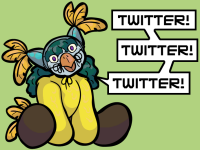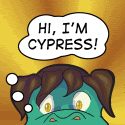Five Tips for Selling Yourself First
Online, an artist is only as good (or as bad) as their reputation. Some key concepts:
1. People don't just want an artist anymore. They want a friend.
Make yourself available. Chill in other comics' forums. For the first few months of your comic's existance, resign yourself to the idea that you're going to be leaching off of other established artist's groups, because quite frankly if you know how to reach any other audience you'd be writing a blog like this one. It may seem counter-intuitive and vaguely insulting, but for what it's worth, it's a lot cheaper than most other advertising routes open to you.
Don't worry about spreading yourself thin; Even if all you do is make a few high-profile posts on a forum, it's probably gotten you some decent legwork done, and that's umpteen more people that know about the comic when they wouldn't have otherwise.
2. They want you to spend some time on them personally.
If you're too busy to talk, your would-be-fans are too enamoured with other people to pay attention to you. Also, let's face it; you're drawing a WEBCOMIC. You have time to burn.
There's a few ways to accomplish this, and either it involves some "Author's Notes/Blog" type comics where you speak directly to the readers using the strip, or you keep a separate blog/LJ as a supplement to the comic. My personal favorite toy in this regard is using Twitter: It encourages you to write very tiny posts, so you can not only keep off-topic-ness to a minimum, but you can write LOTS of them in a day and nobody minds. Heck, that's what it's best used for. It still keeps an archive of everything, and it's accessible from so many places (Facebook comes to mind as the most recent 'new frontier'), so your fans can't help but keep up.
3. They want you to draw not just for their entertainment, but for THEM.
We're talking commissions, guest strips, fanservice, and other little things that give in to a reader's desires. If you're lucky a few of them coincide with each other and someone's commission of your character in a cheesecake pose can be used for merchandise later, effectively allowing you to be paid twice and get some good mileage out of the work. If you decide to do some sexy pinups for the hell of it anyway, don't think "I should be working on the comic instead of this"; think "I can use this as a wallpaper for a donation incentive"!
Unfortunately for you and your wallet, commissions are an outreach of reputation, so your reputation will affect the number of fans, which in turn affect the prices you can charge. The general translation is to wait a little while until people start asking you for art, then offer to charge. If nobody offers, start doing art for your friends, call them 'commissions' (even if they're technically freebies), and see if that gets more people to bite once they realize you're not above drawing their characters.
4. Keeping your readers informed on your life helps them care for you as a person.
Keeping a good comic is Internet Karma: Be good to the net, the net is good to you. Even if you're doing just fine without people's help, you'll still want them to donate, because money is a great incentive (especially to other people who wonder why you're "wasting your time"!). The more you can convince your readers you're an all-around awesome person and you can use the cash wisely, the more they'll give you what you need.
When you DO fall on hard times, you'll want the press to keep you afloat and your fans to keep looking out for you; you can't very well do it when you're laid up, so you may as well earn the karma now while you're healthy.
5. Be aware of the 'content flow'. More importantly, make sure it's consistent.
People like an artist they can keep their watches to, if only because it means they stand half a chance of keeping up with their work. Reading the archives of a webcomic can be daunting, especially if the comic in question is old. The best solution available is to make sure that users don't fall behind any more than they have to, which typically means update schedules for everyone's sanity.
How to decide on an update schedule: Figure out how many strips a week you can do when you're at your absolute goddamn worst and there's three finals to study for. Set the schedule accordingly; we want to aim for your minimum amount you can accomplish in a week, so you don't kill yourself trying to update too quickly. As a bonus, it also gives you a chance to work ahead and save future strips (known as a buffer or a backlog) so when cool stuff comes up, like conventions, trips, or just plain "I-don't-feel-like-it"-itis, you still have stuff waiting to go.
Don't worry about ever having 'too much' backlog, either; Howard Tayler keeps around 30-50 strips in his buffer fairly constantly, and I'm sitting on sixteen weeks of strips as of writing this post. Of course, we have different reasons for keeping them; Howard uses an automatic updater and being paranoid about his ability to produce the strip later always works in his favor, so keeping the buffer huge is a big advantage for him, while I'm building my buffer during the summer months so I can update at college with very little stress involved, or possibly speed up my update rate if it becomes insane to manage.
If you ever do have to do without a strip, at least put up something so your fans know something's up. Get Guest Strips and Fan Art to fill the void while you're out. You can accelerate the schedule or supplement it (like I'm doing with this blog), but slowing it down tends to leave a bad taste in people's mouths. Respect the update schedule, you respect the fans.
Respect the fans, and they respect you.







0 Comments:
Post a Comment
Subscribe to Post Comments [Atom]
<< Home